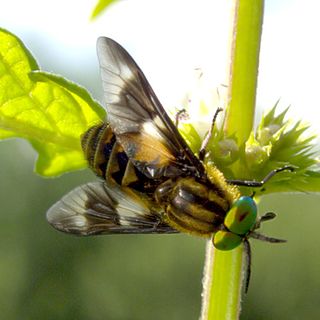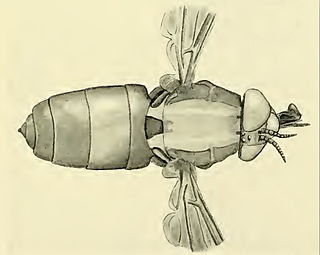
Aequidens is a genus of fish in the family Cichlidae found in South America. Formerly a wastebasket genus, as presently defined Aequidens is largely restricted to the Amazon Basin, Orinoco Basin and river basins in The Guianas. The only exceptions are A. plagiozonatus which also occurs in the Paraná Basin, and A. tetramerus which also occurs in the Parnaíba River.

Caturus is an extinct genus of predatory marine fishes in the family Caturidae in the order Amiiformes, related to modern bowfin. It has been suggested that the genus is non-monophyletic with respect to other caturid genera.

Nemesiidae is a family of mygalomorph spiders first described by Eugène Simon in 1889, and raised to family status in 1985. Before becoming its own family, it was considered part of "Dipluridae". The family is sometimes referred to as wishbone spiders due to the shape of their burrows.

Parmaturus is a genus of deepwater catsharks in the family Pentanchidae. Four species were described in 2007 and another in 2019 with more species likely to be described in the near future.

Eptesicus is a genus of bats, commonly called house bats or serotine bats, in the family Vespertilionidae. The genus name is likely derived from the Greek words ptetikos 'able to fly' or petomai 'house flier', although this is not certain.

Glyptolithodes cristatipes, also known as the Peruvian centolla, is a species of king crab, and the only species in the genus Glyptolithodes. The species was briefly placed in the related genus Rhinolithodes after its initial description, but was soon moved to its own genus.

Superfamily Tabanoidea are insects in the order Diptera.

Panphagia is a genus of sauropodomorph dinosaur described in 2009. It lived around 231 million years ago, during the Carnian age of the Late Triassic period in what is now northwestern Argentina. Fossils of the genus were found in the La Peña Member of the Ischigualasto Formation in the Ischigualasto-Villa Unión Basin. The name Panphagia comes from the Greek words pan, meaning "all", and phagein, meaning "to eat", in reference to its inferred omnivorous diet. Panphagia is one of the earliest known dinosaurs, and is an important find which may mark the transition of diet in early sauropodomorph dinosaurs.

Arene is a genus of small sea snails that have a calcareous operculum, marine gastropod molluscs in the family Areneidae.

Pelecorhynchus is a genus of flies from the family Pelecorhynchidae. The adults mostly feed on nectar of Leptospermum flowers. Larvae have been collected in the damp margins of swamp areas, where they feed on earthworms.

The saddle-back tamarins are squirrel-sized New World monkeys from the family Callitrichidae in the genus or subgenus Leontocebus. They were split from the tamarin genus Saguinus based on genetic data and on the fact that saddle-back tamarins are sympatric with members of Saguinus to a greater extent than would be expected from two members of the same genus. However, this argument can be circular, as several other mammals show sympatry among congeneric species, such as armadillos, spotted cats, and fruit-eating bats. Some authors still consider Leontocebus to be a subgenus of Saguinus.

Lonchophylla inexpectata is a species of leaf-nosed bat found in Brazil.
Mongeperipatus solorzanoi, also known as Solórzano's velvet worm, is a species of velvet worm in the family Peripatidae. This species is the largest known velvet worm, reaching 22 cm in length. This velvet worm is found in the Caribbean coastal forest of Costa Rica.

Thaumatodracon is a genus of rhomaleosaurid pliosaur from the early Jurassic found in the United Kingdom. It contains a single species, named by Adam Smith and Ricardo Araújo in 2017.

Chrysopsinae is an insect subfamily in the family Tabanidae commonly known as deer flies or sheep flies and are bloodsucking insects considered pests to humans and cattle. They are large flies with large brightly-coloured compound eyes, and large clear wings with dark bands. They are larger than the common housefly and smaller than the horse-fly.

Pangoniinae is a subfamily of horse-flies in the order Diptera, containing at seven tribes and over 40 genera.
Fortignathus is an extinct genus of dyrosaurid or peirosaurid crocodylomorph known from the Late Cretaceous Echkar Formation in Niger. It contains a single species, Fortignathus felixi, which was originally named as a species of Elosuchus in 2002.
Epiperipatus hyperbolicus is a species of velvet worm in the family Peripatidae. This velvet worm is known only from its type locality in the state of Alagoas in Brazil. The species name refers to the unusually large apical piece on the primary papillae on this velvet worm. This distinctive apical piece is notable for its size and spherical shape. The males of this species have 23 pairs of legs; females have 24 or 25 pairs.
Rhigioglossa is a genus of horse flies in the family Tabanidae.















